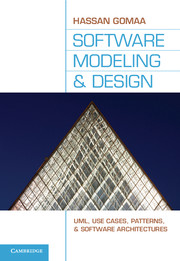Book contents
- Frontmatter
- Contents
- Preface
- Annotated Table of Contents
- Acknowledgments
- PART I Overview
- PART II Software Modeling
- 6 Use Case Modeling
- 7 Static Modeling
- 8 Object and Class Structuring
- 9 Dynamic Interaction Modeling
- 10 Finite State Machines
- 11 State-Dependent Dynamic Interaction Modeling
- PART III Architectural Design
- PART IV Case Studies
- Appendix A Catalog of Software Architectural Patterns
- Appendix B Teaching Considerations
- Glossary
- Answers to Exercises
- Bibliography
- Index
8 - Object and Class Structuring
from PART II - Software Modeling
Published online by Cambridge University Press: 05 June 2012
- Frontmatter
- Contents
- Preface
- Annotated Table of Contents
- Acknowledgments
- PART I Overview
- PART II Software Modeling
- 6 Use Case Modeling
- 7 Static Modeling
- 8 Object and Class Structuring
- 9 Dynamic Interaction Modeling
- 10 Finite State Machines
- 11 State-Dependent Dynamic Interaction Modeling
- PART III Architectural Design
- PART IV Case Studies
- Appendix A Catalog of Software Architectural Patterns
- Appendix B Teaching Considerations
- Glossary
- Answers to Exercises
- Bibliography
- Index
Summary
After defining the use cases and developing a static model of the problem domain, the next step is to determine the software objects in the system. At this stage, the emphasis is on software objects that model real-world objects in the problem domain.
Software objects are determined from the use cases and from the static model of the problem domain. This chapter provides guidelines on how to determine the objects in the system. Object structuring criteria are provided, and the objects are categorized by using stereotypes. The emphasis is on problem domain objects to be found in the real world and not on solution domain objects, which are determined at design time.
The static modeling described in Chapter 7 was used to determine the external classes, which were then depicted on a software system context class diagram. These external classes are used to help determine the software boundary classes, which are the software classes that interface to and communicate with the external environment. The entity classes and their relationships were also determined during static modeling. In this chapter, the objects and classes needed in the software system are determined and categorized. In particular, the focus is on the additional software objects and classes that were not determined during the static modeling of the problem domain.
The static relationship between classes is considered in the static model, as described in the previous chapter, and the dynamic relationship between the objects is considered in the dynamic model, as described in Chapters 9, 10, and 11.
- Type
- Chapter
- Information
- Software Modeling and DesignUML, Use Cases, Patterns, and Software Architectures, pp. 115 - 131Publisher: Cambridge University PressPrint publication year: 2011



